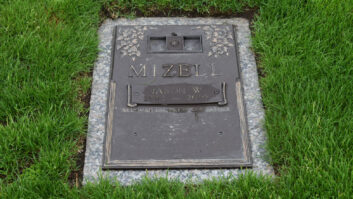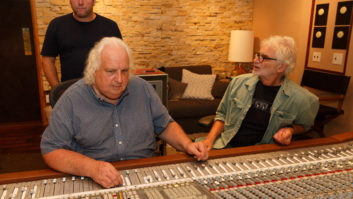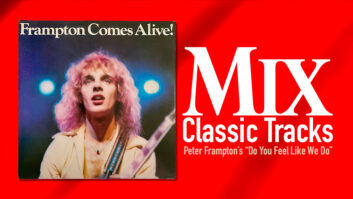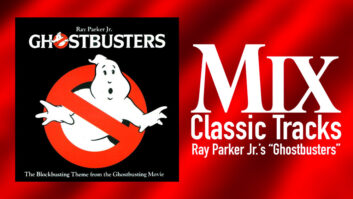
It’s a good thing Aerosmith needed a break one day while recording a track at Record Plant New York for their most successful album, Toys in the Attic. The unforgettable smash song “Walk This Way” likely would not have come to be if the musicians in the studio hadn’t gotten itchy and decided to head down the block to the movies, to see a Mel Brooks comedy that had everybody repeating one-liners back in the ’70s.
“We all took a break and went to see Young Frankenstein,” recalls recording engineer Jay Messina. “And that line that Marty Feldman said when he turned around to Gene Wilder and handed him his cane and said, ‘Walk this way,’ is where the birth of the song came from.”
Messina says that the luxury of a movie break in the middle of a session probably wouldn’t happen now, given today’s smaller budgets (or maybe it still would, if you’re Aerosmith), but thankfully it did back then because it led to a great Top 10 song.
Messina’s relationship with Aerosmith stemmed from his work with producer Jack Douglas whom he met at The Record Plant when Douglas was an assistant back in 1971.
“He got assigned to one of my sessions and we hit it off right away,” Messina recalls. “I liked him because I didn’t have to tell him every single thing to do. So when he got an opportunity to produce, it was a natural choice for Jack to pick me.”
Messina had worked on the Boston-formed band’s second album, Get Your Wings (1974), and then again joined them at Record Plant for Toys in the Attic in 1975.
“Jack would get quite involved musically with the band, and lots of times have cool musical ideas for them that they were very receptive to, but generally it was Steven [Tyler, lead singer] and Joe [Perry, guitarist] that were the creative driving force,” Messina says.
Messina listened back to the song to jog his memory in preparation for this interview, and the first thing that jumped out at him was that Perry’s riff was on the left side, which was unusual for the way he remembers mixing the band as a rule.
“Generally, from my recollection, when we used to mix Aerosmith, Brad (Whitford, guitarist), was usually on the left and Joe was on the right,” Messina says. “It was Joe’s riff, and Joe plays all the lead, which comes on the right, so that’s confusing.”
Classic Tracks: Steppenwolf’s “Born to Be Wild”
There seems to be little doubt that Perry created and played the famous riff. He owns it in live performance, and every year more young musicians learn to play the famous part in his style.
Messina recalls that most of the recording for Toys in the Attic was captured to a custom-built 16-track MCI tape machine, and he says about 90 percent of the mixes were done in Studio A on a Spectrasonics console; unfortunately, he says, the board was not terribly versatile as far as “being able to do lots of technical tricks.”
Joey Kramer wasn’t in an isolated drum booth, Messina recalls, but was set up in the studio on a little platform with low baffles built around it, not high enough to obstruct his vision of the rest of the room. “We would see him from the shoulders up looking out from the control room,” Messina explains. The drum mics, he says, were probably Sennheiser 421s on the toms and U87 overheads, a Neumann KM84 on the hi-hat and an Electro-Voice 666 on the kick drum.
“We had [bassist] Tom Hamilton going through an [Ampeg] B15 amp, where we took an output—a custom direct out of the head of the amp—and we would mike it with an RE20,” Messina adds. “Then just on the other side of the glass in the control room was a section of wood, which is where we used to record strings, and that’s where we had the two guitar amps.
“We would usually use three mics on a guitar and combine them and then maybe compress that track with a Pultec after it,” the engineer continues. “If it gave the guitar sound a little extra edge to add some flanging effect in there, we would just mix it in and print it. So with that kind of mindset, that’s how you could end up with an open track [for possible overdubs later] and not have to worry about getting that guitar sound again that everybody loved that particular day. That’s the beauty and advantage of printing these effects. If you love it and print it, you know you’ve got it. We used to make commitments and print.”
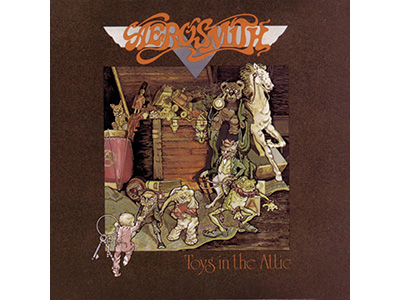
Messina says the band and production team would usually nail down drum sounds first, then they would work with Hamilton on bass sounds. Guitar sounds would be next, and then the band would begin recording live, all together.
“That’s not to say we necessarily kept those [live] performances, but chances are we kept the bass and drums,” Messina says.
The music for “Walk This Way” was written before the band had lyrics ready, so basic tracks were laid down without Tyler present. This meant that after Perry and Tyler finished writing the words, the singer had a complete track to sing to, but as Messina notes, the recorded track was also rapid-fire, so once the lyrics were complete, Tyler had to sing fast and furious.
“I can’t take anything away from Steven,” Messina says. “That’s where it starts. He was able to deliver those lyrics that way. I’ve always said, ‘If you want to get a good drum sound, start with a good drummer.’ Same thing: If you want to get a good vocal sound, get a good singer.”
Messina believes Tyler’s vocal chain included a Neumann U87, a Teletronix LA-2A and a Pultec, “which maybe I took some 30 cycles out and then added at 10k.” Tyler also overdubbed some triangle, to create the school bell sounds in the song.
The guitar solo that ends the track in a fade is all one track, Messina says. “When we mixed, that was probably a 30 ips delay on the opposite side of the lead track, which is what gives it that spread,” he says. “That was probably a Fender Twin. At Record Plant, we used to have these vintage amplifiers. They were small amps that had really meaty power without tearing your head off with volume. Probably three mics [were used]: a Sony C37, which provided the meat and bottom end of the sound, an SM57, and a Sennheiser MD421, which provided the edge. The combination of all three was compressed through a UA 1176, followed by some boost at 5k in a Pultec EQP-1A.”
Messina says that when he hears “Walk This Way” or “Sweet Emotion,” he feels a particular sense of pride to have been involved in the project. “It makes me feel good that they still play something that I was involved in so many years ago,” he says.
In 1977 Aerosmith’s “Walk This Way” peaked at Number 10, and then in 1986 the song served as a bridge to a new genre of music when producer Rick Rubin introduced it and the band Aerosmith to a breakout group called Run-D.M.C.
The Run-D.M.C. version of “Walk This Way,” from their album Raising Hell, marries Perry’s classic riff and Tyler’s vocals with scratching and rapping; the groups’ sound is often credited with helping to break hip-hop and rap into the mainstream. The rap-rock version of “Walk This Way” became the first song of its genre to make it into the Top 5 on the Billboard pop charts.
“I was really glad to hear it,” Messina says. “I thought it was great. It gave that song new life.”
This Classic Track was originally posted in March, 2017.
